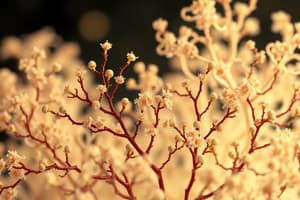Podcast
Questions and Answers
What is the primary function of the high salt concentration in Mannitol salt Agar?
What is the primary function of the high salt concentration in Mannitol salt Agar?
- To inhibit the growth of Gram-negative bacteria
- To facilitate the detection of acid production
- To distinguish between lactose fermenters and non-fermenters
- To allow only Staphylococcus species to grow (correct)
What is the purpose of Crystal Violet in MacConkey Agar?
What is the purpose of Crystal Violet in MacConkey Agar?
- To detect the presence of starch
- To inhibit the growth of Gram-positive bacteria (correct)
- To indicate the presence of acid fermentation products
- To distinguish between lactose fermenters and non-fermenters
What is the characteristic of colonies that have undergone starch hydrolysis on Starch Agar?
What is the characteristic of colonies that have undergone starch hydrolysis on Starch Agar?
- They appear clear around the colonies (correct)
- They appear transparent and colorless
- They appear red or pink
- They appear blue-black
What is the purpose of Phenol red in Carbohydrate Fermentation tests?
What is the purpose of Phenol red in Carbohydrate Fermentation tests?
What is the primary function of Eosin Methylene Blue in Eosin Methylene Blue Agar?
What is the primary function of Eosin Methylene Blue in Eosin Methylene Blue Agar?
What is the characteristic of non-fermenters on MacConkey Agar?
What is the characteristic of non-fermenters on MacConkey Agar?
What is the purpose of the phenol red indicator in the enzyme system test?
What is the purpose of the phenol red indicator in the enzyme system test?
What is the byproduct of tryptophan being broken down by tryptophanase in the SIM test?
What is the byproduct of tryptophan being broken down by tryptophanase in the SIM test?
What is the function of citrate permease in the citrate test?
What is the function of citrate permease in the citrate test?
What is the result of a positive urease test?
What is the result of a positive urease test?
What is the purpose of the gelatinase enzyme in the gelatin hydrolysis test?
What is the purpose of the gelatinase enzyme in the gelatin hydrolysis test?
What is the indicator used to detect hydrogen sulfide production in the SIM test?
What is the indicator used to detect hydrogen sulfide production in the SIM test?
Flashcards are hidden until you start studying
Study Notes
Selective and Differential Media
-
Mannitol salt agar:
-
High salt concentration (7%) inhibits other species, allowing Staphylococcus to grow
-
Salt-tolerant bacteria grow, while others are inhibited
-
Differential test: acid production (yellow color) indicates Mannitol fermentation, while non-fermenters remain colorless
-
MacConkey agar:
-
Contains bile salts and crystal violet to inhibit Gram-positive bacteria
-
Distinguishes between enterics: lactose fermenters (coliforms) and non-fermenters
-
Lactose fermenters produce acidic pH, resulting in red/pink colonies
-
Non-fermenters produce no color change or remain transparent
-
Eosin methylene blue agar:
-
Contains eosin methylene blue to inhibit Gram-positive bacteria
-
Distinguishes between lactose fermenters and non-fermenters
-
Coliform (lactose fermenters) produce red/pink or green metallic colonies
-
Non-fermenters produce transparent colonies
Biochemical Tests
Starch Hydrolysis
- Breakdown of polysaccharide starch into glucose by amylase
- Add iodine to detect starch presence: blue-black color indicates no hydrolysis (negative), while clear zones around colonies indicate hydrolysis (positive)
Phenol Red Carbohydrate Fermentation
- Yellow color indicates acid fermentation products and bubble formation in tube
- Pink color indicates alkaline end products
- Enzyme systems produce acids and gas, detected by phenol red indicator
- Red/orange color indicates negative results, while yellow indicates positive results
Urease Test
- Urea + water (urease) = CO2 + water + ammonia (pink color, alkaline pH)
- Yellow color indicates acidic pH, while red indicates neutral pH
- Negative results: yellow, Positive results: hot pink
Gelatin Hydrolysis
- Hydrolytic exoenzyme (gelatinase) breaks down gelatin into amino acids
- Liquified agar deep (after cooling) indicates positive results, while solid agar deep indicates negative results
SIM Tests
1. Hydrogen Sulfide Production
- Cysteine + cysteine desulfurase = H2S + pyruvic acid
- H2S + ferrous sulfate (indicator) = ferric sulfide (black precipitate)
- Black agar deep indicates positive results, while yellow agar deep indicates negative results
2. Indole Production
- Tryptophan broken down by tryptophanase into indole, pyruvic acid, and ammonia
- Indole detected by Kovac's reagent, resulting in a red/pink layer on top of agar deep
- Yellow layer on top of agar deep indicates negative results
3. Motility
- Detected by growth beyond the line of inoculation
- Growth diffusion away from the stab of inoculation indicates positive results, while growth restricted to the stab line indicates negative results
Catalase Test
- Hydrogen peroxide broken down by catalase into water and oxygen gas (bubbling)
- Bubbles indicate positive results, while no bubbles indicate negative results
Citrate Test
- Citrate in media as the sole carbon source
- Citrate enters cells using citrate permease and is broken down by citrase
- +/- result indicates alkaline end products, resulting in a blue color change and growth on the agar slant
Studying That Suits You
Use AI to generate personalized quizzes and flashcards to suit your learning preferences.




